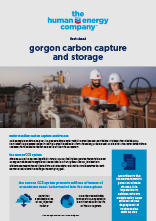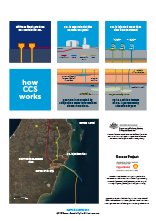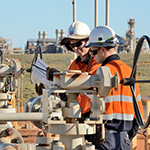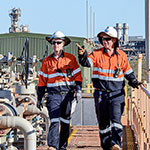media statement chevron australia CO2 injection milestone
PERTH, Western Australia, 19 July 2021 – Chevron Australia is poised to reach a significant milestone at its Gorgon LNG facility, injecting five million tonnes of greenhouse gas (carbon dioxide equivalent, CO2e) since safely starting the system in August 2019.
The milestone represents the largest volume of injection achieved within this time frame by any environmental carbon capture and storage (CCS) system of comparable specifications.
Injecting five million tonnes of CO2e is equivalent to taking more than 1.6 million passenger vehicles off Australia’s roads for a year1.
“This significant milestone shows how we’re deploying technology, innovation and skills to deliver cleaner energy and reduce our carbon footprint,” Chevron Australia managing director Mark Hatfield said.
“The Gorgon carbon capture and storage (CCS) system is the biggest CCS system designed to capture carbon emissions and is demonstrating Australia’s world-leading capability in the area.”
Once fully operational, the system will capture up to 4 million tonnes of CO2 annually and reduce greenhouse gas emissions by more than 100 million tonnes over the life of the injection project.
The system works by taking naturally occurring CO2 from offshore gas reservoirs and injecting it in a giant sandstone formation two kilometres under Barrow Island, where it remains trapped.
It prevents millions of tonnes of greenhouse gases being vented into the atmosphere.
Hatfield said while the system had delivered significant reductions in Gorgon’s emissions, the time taken to safely start the system meant Chevron had not met injection requirements.
"Chevron is working with the WA regulator on making up the shortfall and will report publicly on that later in the year," Hatfield said.
“Like any pioneering endeavour, it takes time to optimise a new system to ensure it performs reliably over 40-plus years of operation.
“The road hasn’t always been smooth, but the challenges we’ve faced – and overcome – make it easier for those who aspire to reduce their emissions through CCS.
“We’re committed to sharing the lessons we’ve learned with state and federal governments, research institutes and other energy producers to assist the deployment of CCS in Australia.
“CCS is a proven technology which experts agree is critical to achieving a lower carbon future while ensuring access to affordable and reliable energy for billions around the world who rely on it.”
The Chevron-operated Gorgon Project is a joint venture between the Australian subsidiaries of Chevron (47.333 percent), ExxonMobil (25 percent), Shell (25 percent), Osaka Gas (1.25 percent), Tokyo Gas (1 percent) and JERA (0.417 percent).
Chevron is one of the world's leading integrated energy companies and through its Australian subsidiaries, has been present in Australia for more than 60 years. With the ingenuity and commitment of thousands of workers, Chevron Australia operates the Gorgon and Wheatstone natural gas facilities; manages its equal one-sixth interest in the North West Shelf Venture; operates Australia’s largest onshore oilfield on Barrow Island; is a significant investor in exploration; and via Puma Energy delivers quality fuel products and services across Australia, operating or supplying a network of more than 360 retail locations and an extensive 24-hour hour diesel stop network, as well as 14 depots and three seaboard terminals.
[1] Based on estimation light vehicles (cars, 4x4s, SUVs and small commercial vehicles up to 3.5 tonnes) emit 3 tonnes of greenhouse gases a year. Department of Industry, Science, Energy and Resources.
Cam Van Ast
Phone: +61 (8) 9216 4462 (Perth)
Cautionary statement relevant to forward-looking information for the purpose of “Safe Harbor” provisions of the Private Securities Litigation Reform Act of 1995
This press release contains forward-looking statements relating to Chevron’s operations that are based on management’s current expectations, estimates and projections about the petroleum, chemicals and other energy-related industries. Words or phrases such as “anticipates,” “expects,” “intends,” “plans,” “targets,” “forecasts,” “projects,” “believes,” “seeks,” “schedules,” “estimates,” “positions,” “pursues,” “may,” “could,” “should,” “budgets,” “outlook,” “trends,” “guidance,” “focus,” “on schedule,” “on track,” “is slated,” “goals,” “objectives,” “strategies,” “opportunities” and similar expressions are intended to identify such forward-looking statements. These statements are not guarantees of future performance and are subject to certain risks, uncertainties and other factors, many of which are beyond the company’s control and are difficult to predict. Therefore, actual outcomes and results may differ materially from what is expressed or forecasted in such forward-looking statements. The reader should not place undue reliance on these forward-looking statements, which speak only as of the date of this report. Unless legally required, Chevron undertakes no obligation to update publicly any forward-looking statements, whether as a result of new information, future events or otherwise.
Among the important factors that could cause actual results to differ materially from those in the forward-looking statements are: changing crude oil and natural gas prices; changing refining, marketing and chemicals margins; the company’s ability to realize anticipated cost savings and expenditure reductions; actions of competitors or regulators; timing of exploration expenses; timing of crude oil liftings; the competitiveness of alternate-energy sources or product substitutes; technological developments; the results of operations and financial condition of the company’s suppliers, vendors, partners and equity affiliates, particularly during extended periods of low prices for crude oil and natural gas; the inability or failure of the company’s joint-venture partners to fund their share of operations and development activities; the potential failure to achieve expected net production from existing and future crude oil and natural gas development projects; potential delays in the development, construction or start-up of planned projects; the potential disruption or interruption of the company’s operations due to war, accidents, political events, civil unrest, severe weather, cyber threats and terrorist acts, crude oil production quotas or other actions that might be imposed by the Organization of Petroleum Exporting Countries, or other natural or human causes beyond its control; changing economic, regulatory and political environments in the various countries in which the company operates; general domestic and international economic and political conditions; the potential liability for remedial actions or assessments under existing or future environmental regulations and litigation; significant operational, investment or product changes required by existing or future environmental statutes and regulations, including international agreements and national or regional legislation and regulatory measures to limit or reduce greenhouse gas emissions; the potential liability resulting from other pending or future litigation; the company’s future acquisition or disposition of assets or shares or the delay or failure of such transactions to close based on required closing conditions; the potential for gains and losses from asset dispositions or impairments; government-mandated sales, divestitures, recapitalizations, industry-specific taxes, changes in fiscal terms or restrictions on scope of company operations; foreign currency movements compared with the U.S. dollar; material reductions in corporate liquidity and access to debt markets; the impact of the 2017 U.S. tax legislation on the company’s future results; the effects of changed accounting rules under generally accepted accounting principles promulgated by rulesetting bodies; the company’s ability to identify and mitigate the risks and hazards inherent in operating in the global energy industry; and the factors set forth under the heading “Risk Factors” on pages 19 through 22 of the company’s Annual Report on Form 10-K. Other unpredictable or unknown factors not discussed in this report could also have material adverse effects on forward-looking statements.



